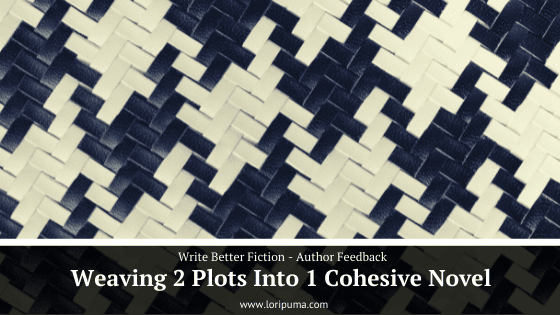Weaving 2 Plots Into 1 Cohesive Novel
/Does your novel have an action plot and a protagonist with an internal character arc? See how one action/adventure author can weave external and internal plots into one cohesive narrative.
Today’s author is Lexi. She describes her novel as an action/ adventure story. Here’s her summary:
James Henry Matthews the Second and his team of elite assassins take on yet another assignment... at the request of the United States. Still grieving the loss of his brother, James and his team struggle to maintain their prestigious reputation and justify James’ sudden inheritance. But with this case, new revelations unfold and what the team uncovers hits much closer to home. This is a novel, one of three books in a trilogy.
In terms of what she’d like feedback about, Lexi says:
Write a compelling, fun story that successfully handles a main action plot while also weaving in heavy topics that affect today’s youth and adults.
She’s got 61k words and is revising. Her biggest challenge is:
Trying to weave these two very important plots together into one cohesive story.
This is what she says is most important to her about telling this story:
I started this story mainly for my friends that struggle with mental health. I wanted there to be a character that they could relate to, that they could see themselves be, and watch this character overcome the challenges he faces. Since then, it’s only been even more important to me, not only just to my friends, but to others who have this same struggle. It is something I will not give in on when it comes to this story.
This is a clear passion. In the US, 1 in 5 people have a mental illness. Worldwide, 1 in 7 do. Fiction can definitely use more positive portrayals of mental illness. Especially ones that are honest about the challenges people face and kind in how they portray the inevitable setbacks.
When you want to write a fun story about a heavy topic, it’s important to make every aspect of the story as good as it can be so you don’t come off as preachy. Let’s look at the two plots individually and then talk about how to weave those two plots together.
The Two Plots
Here’s how Lexi describes her two plots:
The main plot is James and his team tracking down the person responsible for the attack on D.C. so that it might gain him and his team the prestige they once had before the true heir died a few months ago in a mission gone wrong.
The second plot is James fighting with his mental health that’s been awful from a young age, partly due to his father’s abuse. When his brother dies, it only proceeds to worsen. Slowly, James’ friends help him seek professional help, and successfully free him of his father’s clutches.
The main plot is a hunt. (I’d call it an action/thriller plot.) I’d guess that the main villain is on-the-run or in-hiding. The key scenes will probably show James and team following a trail of clues to find the villain, setting up traps to capture the villain, or operations to assassinate him.
Since James is an assassin, and this is an action plot what readers will expect at the climax, is a showdown between James and the villain that will probably result in the villain’s death. James can decide to neutralize the villain in another way, but the climax of an action plot is some kind of showdown.
The internal journey plot is more fuzzy. We know Lexi wants to have James be a positive portrayal of mental illness throughout her series. But I’m not sure where the starting and ending points are for the multi-book journey or for this first book. (I covered how to determine the starting and ending points for a multi-book character arc in this post.)
I’m going to take a guess and say that the challenge James faces in this first book might be taking the first step to getting professional help. He might start the book thinking, “Asking for help is a weakness,” and end the book thinking, “I’m willing to get help if it will get my teammates off my back.”
That transformation is big enough for readers to recognize that something has changed from the beginning to the end of the book, but not so big that the change feels inauthentic. Lexi has two more books in the series to help James reach the end of his character arc.
For the rest of this post, I’m going to use the above transformation from “Asking for help is a weakness” to “I’m willing to get help if it will get my teammates off my back,”as an example. Lexi can choose whatever starting and ending points she’d like for her novel, but it’s much easier to talk about one specific option in a blog post.
Will your action novel keep readers on the edge of their seats? Take the quiz to see what’s working and what comes next.
Weaving The Plots Together
Now that we know a little more about each of the two plots, how do you combine them into one cohesive story? One where James’ depression impacts his ability to complete his mission (and manage his team), and where the ups and downs of the mission impact his depression.
To weave the plots together, we want to create scenes that show the negative consequences of James’ refusing to deal with his depression and the positive benefits of taking steps to manage his depression. Tracking the down the villain involves all kinds of physical, mental, and emotional challenges. How does James’ depression make those challenges worse? How does getting treatment or a changing attitude make things better? And what setbacks might James and team experience along the way?
Here are some examples of what I mean by challenges, improvements, and setbacks.
How does James’ depression make the mission more difficult?
Is James’ hopelessness bringing down the team’s morale so much that key team members are looking for other jobs?
Does James engage in self-harm activities that mean he’s not at the physical strength or stamina that’s needed for the mission?
Does James have a short temper that makes him so confrontational in interrogations that the team doesn’t get the information they need to complete their mission?
Is the villain able to take advantage of James’ self-blame in order to lure James into a trap?
How does treatment make the mission easier?
Is James able to rebuild trust with a teammate after apologizing for messing up an interrogation because of an angry outburst?
When James starts antidepressants, is James’ newfound focus the differentiator that helps the team complete a group task they’ve previously failed at?
After a few sessions with a therapist, is James ready to allow another team member to try a new, creative approach in tracking the villain? Before, James would have insisted that they stick with traditional methods because that’s what his dad would’ve done. Since James’ brother was killed because James didn’t listen to his dad, James thinks that if he just does things the way his dad would do it, everything will be ok.
What setbacks does James experience that impact the mission?
Maybe James’ team blackmails him into seeing a therapist. The team feels relieved for a week. James goes to the therapist once and then refuses to go again. The team refuses to follow orders and James has to hire subcontractors who don’t conduct surveillance with as much skill as his team would.
Or maybe James starts on an antidepressant and there are side effects like headaches that make it hard for James to do his job. James might refuse to try any other antidepressants because of this experience.
The goal is to brainstorm concrete moments that can serve as snapshots to James’ inner transformation and also impact the overall mission. When events serve have consequences in both plots, it will feel more realistic.
How close are you to crafting a novel readers won’t be able to put down? Take a quiz to see what’s working and what comes next.
Next steps for Lexi
Since Lexi is revising, the next steps are more about evaluating what she’s already got, rather than creating new material. First, get clear on each of the two plots individually.
For the main plot, what are the key scenes? These might be the inciting incident that starts the story, the midpoint, an all is lost moment, the climax, and any other important plot twists. Make a list of these scenes.
For the internal plot, what is the 1-sentence statement that describes what James believes at the beginning of Book 1? What does he believe at the end? What are the belief statements for the other books in the series? What are the key scenes that serve as snapshots to James’ internal journey? Make a list of these scenes.
For more help on determining James’ inner transformation, read this post on multi-book character arcs and go through the recommended Next Steps.
Second, evaluate the weave between the two plots. Take the lists of the key scenes from above.
For each action scene, does James’ depression help or hurt the team or is it neutral? You want all of the action scenes to have an impact on James’ internal journey. The impact can be direct or indirect, but there should be a relationship.
Does James’ depression make a difficult mission situation worse? Does James’ depression create problems for the mission that wouldn’t exist if he had better coping skills? Does James lack perspective and get overly upset about mistakes by himself or other teammates? These are experiences that are going to cause James enough pain so that he’ll be willing to change at least a little by the end of the novel.
For each internal journey snapshot, evaluate how James’ treatment (or lack thereof) or a change in attitude impacts the mission. Some of the snapshots may be times when James is interviewing witnesses or on a stakeout, or in a shootout. Those are times when the depression can have a direct effect on the mission. For snapshots that are more removed from the mission, like scenes of James talking with his teammates, calling potential therapists, or blowing off steam after a fight, the impact of the depression will be more subtle.
How does treatment or a change in attitude provide tangible benefits to the mission and the team? Does treatment prevent issues that have plagued the team before? Do James’ new coping skills make new options for completing tasks possible? Are damaged relationships repaired?
Are there situations that have both negative and positive consequences? Maybe there’s a short-term benefit, but a long-term cost? Or a short-term cost with a longer-term benefit?
When someone is depressed in real life, it affects every aspect of their life. Stories that show a character learning to manage depression will feel more authentic if they’re honest about the challenges. When Lexi’s two plots that feel like they can’t exist without the other, she’s letting readers know that she’s not trying to sugarcoat reality. She understands how difficult depression can be, and any positive message she offers will feel more genuine.
Enjoy this post? Join my email list so you’ll know when I publish the next author feedback post.
Or maybe you’ve got a fantasy, sci-fi, romance, mystery, or thriller for adult or young adult readers that you want feedback on? Submit your story.






